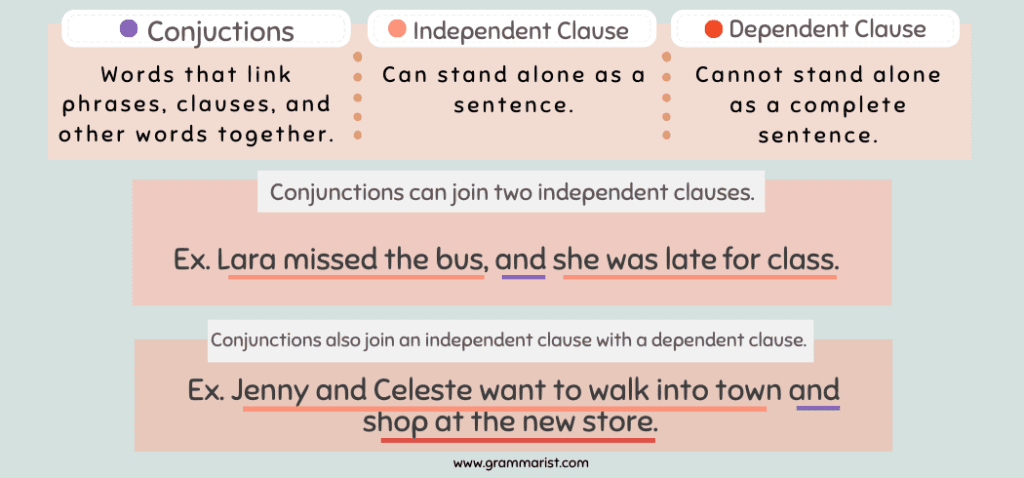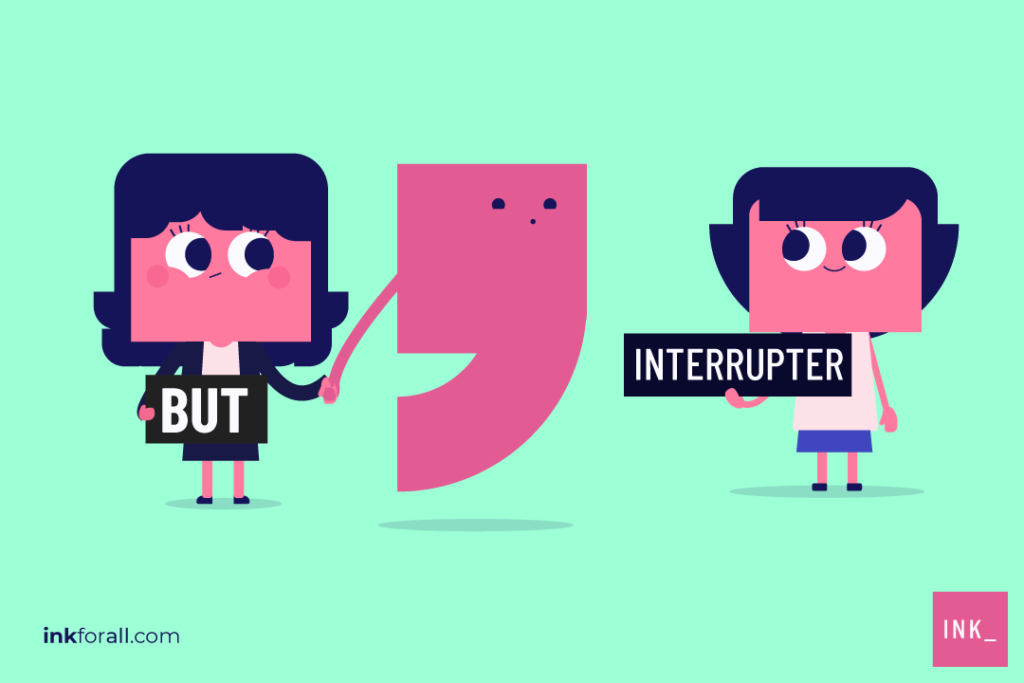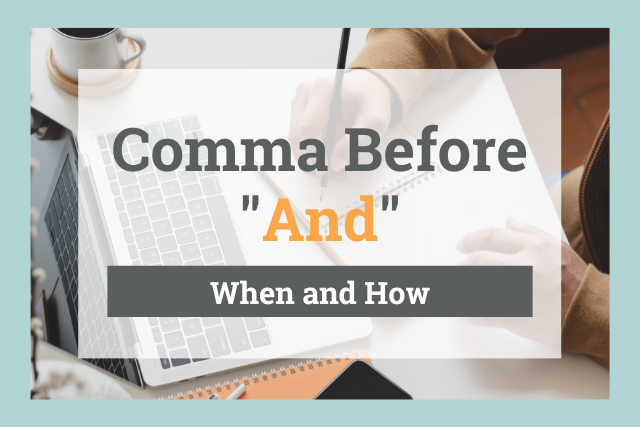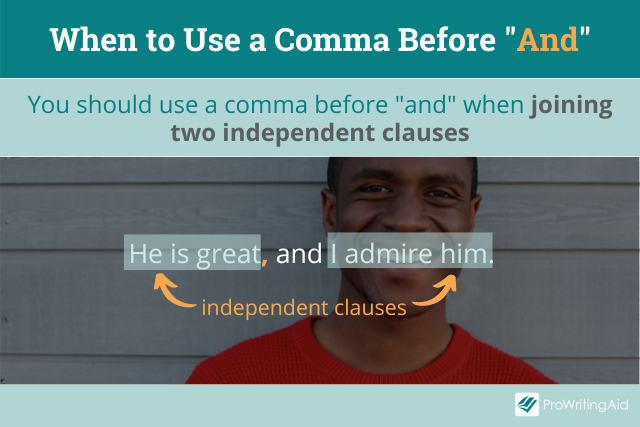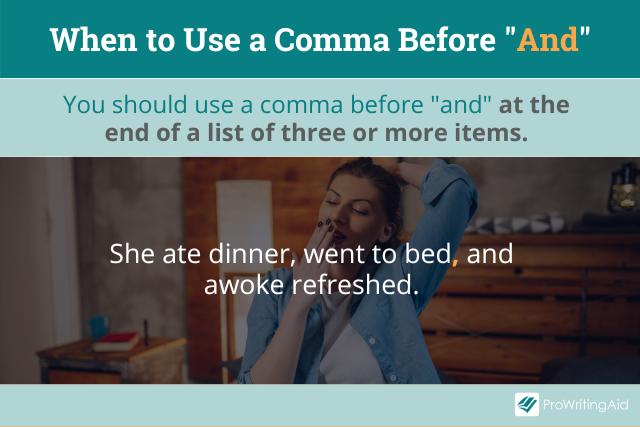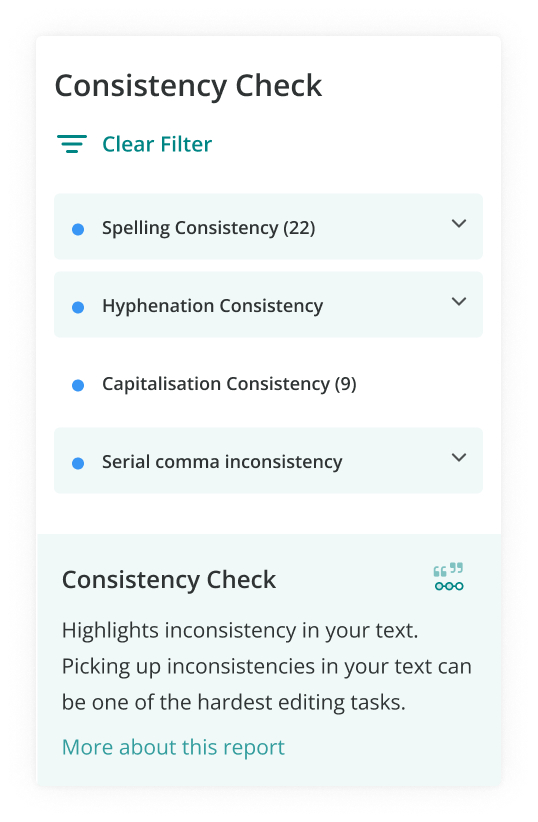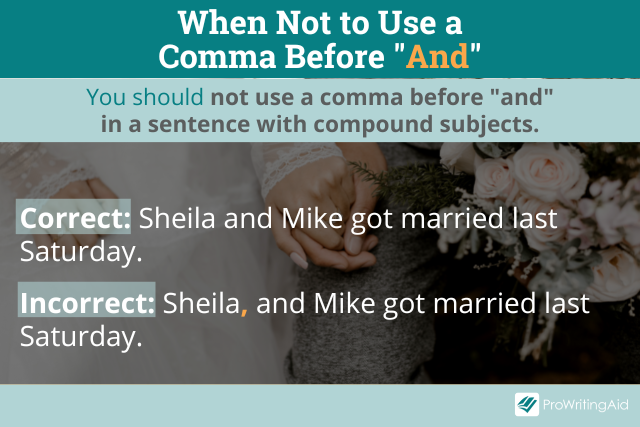Commas are probably one of the most confusing punctuation marks to use, and even I struggle to find ways to help my students determine where they belong.
One of the most commonly asked questions I hear surrounds whether to place a comma before or after the word “and.” Unfortunately, the answer is not quick or simple. However, the comma rules concerning the word “and” is not difficult to understand.
I’m going to start simple and explain how the word “and” is used and then provide rules on punctuation surrounding comma usage so you can understand where they belong together. I’ve also provided plenty of examples below.
Common Coordinating Conjunctions and Compound Sentences
Conjunctions are words that link phrases, clauses, and other words together. They allow you to form compound-complex sentences to enhance the flow of your writing and speech.
Coordinating conjunctions include the words for, and, nor, but, or, yet, and so. The guide to comma usage in relation to conjunction use are the same for all of them, but the word “and” is more used than any other choice.
Conjunctions can join two independent clauses or clauses that could work as stand-alone sentences.
For example, the following two independent clauses:
- Lara missed the bus. She was late for class.
Becomes
- Lara missed the bus, and she was late for class.
Conjunctions also join an independent clause with a dependent clause or clause that cannot stand alone as a complete sentence.
For example:
- Lara needs to start getting to class on time and make sure her homework is complete.
Rules of Comma Usage
There are six basic rules of comma use, but I find it is much easier to teach each rule independently of one another with plenty of examples. Such is the case with commas and conjunctions.
Using “And” to Join Two Independent Clauses: Comma BEFORE “And”
When “and” joins together two independent clauses, a comma needs to be placed before the “and.” Independent clauses are complete sentences, but their conjoining makes a complex-compound sentence. The comma works to indicate this use.
For example:
- I hate having to get up early for work, and getting chores done at that time of the morning is exhausting.
- It hasn’t rained in our town or the surrounding areas, and the lack of rain is starting to make everyone very anxious.
- I’m so glad the end of the week is nearing, and I can’t wait until I can sleep in this weekend.
Using “And” with a Dependent Clause: No Comma
If you are joining together an independent clause with a dependent clause, you do not use a comma.
For example:
- Jenny and Celeste want to walk into town and shop at the new store.
- Wyatt wanted to study Marine Biology and go to a summer camp for more experience.
- Sarah got in big trouble at school for fighting and was suspended for ten days.
Using “And” with Short Independent Clauses: No Comma
Even though they are technically independent, it is acceptable to avoid the comma for shorter sentences.
For example:
- Emmett likes trains and Emily likes horses.
- Mary likes math and John likes writing.
- Javier likes football and Mark likes lacrosse.
Using “And” with List Items:
Depending on how many items you have to list determines whether you use commas in lists with the “and.” There are also multiple ways to approach whether you use a comma or not, which can cause quite a bit of confusion.
Take a look at the examples below to determine which approach works best for you.
Two Items: No Comma
When listing two items, you do not use a comma before the “and.”
For example:
- I need to run to the store for milk and butter.
- She couldn’t decide between art and choir.
- He played in the band and played football.
Three or More Items: Serial Comma BEFORE “And”
The use of a comma before the word “and” when listing three or more items has been a topic of hot debate for many years. This quirk of comma usage is called a serial comma – a comma used in a series of items. It is also called the Oxford comma.
The Oxford comma’s rules state that a comma belongs between the last two items in a series of three or more items to avoid ambiguity. The serial comma controversy is addressed in the the AP Style Guide stating the Oxford comma is grammatically incorrect. But, linguists everywhere will agree it is a grammatical option.
In fact, there has been a lawsuit about a job description that offered two different interpretations of an exception rule: in this case, whether overtime was owed. The judge ruled an Oxford comma was required to include the last item in the list concerning exception, but since it was not used, the item was not part of the list, and overtime was indeed owed.
I also teach the Oxford comma in order to ensure clarity and avoid confusion. Without it, some pretty amusing situations can occur.
For example:
- Rachel finds inspiration in cooking, her dog and family.
- We went to the concert with neighborhood friends, Grandma and Grandpa.
The first sentence sounds like Rachel cooks her dog and her family. In the second sentence, it sounds like the neighborhood friends are named grandma and grandpa.
Instead of accidentally creating this confusion, simply use an Oxford comma to create clarity.
For example:
- Rachel finds inspiration in cooking, her dog, and her family.
- We went to the concert with neighborhood friends, Grandma, and Grandpa.
When to Use Commas AFTER “And”
A comma is almost never used after the word “and.” However, there are a few exceptions. In general, do not place a comma after “and” unless the following is true:
“And” is Used to Introduce a Parenthetical Expression
A parenthetical expression is a non-essential phrase that is offset from the main sentence to add detail or information.
For example:
- I have to drive to Texas every two weeks for a doctor’s appointment, and, if I’m lucky, I have extra time to do a little shopping.
“And” is Used in a Line of Dialog
Written dialog may require a comma following an “and” depending on the style and tone the author is trying to create with a character.
For example:
- “And,” Michael dictated, “you have to be up two hours before daybreak if you want to get there on time.”
Let’s Review
A comma is almost never used after the word “and,” barring a few exceptions, but it is commonly used before when you combine two complete sentences into a compound sentence or when listing more than two items.
It is important to use commas properly to avoid overuse and help ensure writing clarity. Like I tell my students, when you look at one grammar rule at a time and practice its application, you will almost always remember its use.
Is there a comma after and?
If the word “and” is used to join two independent clauses, then there should be a comma before the “and” and never after it. You might want to include a comma after the “and”, but this is never correct.
How do you know when to put a comma?
Comma Use
- Use commas to separate independent clauses when they are joined by any of these seven coordinating conjunctions: and, but, for, or, nor, so, yet.
- Use commas after introductory a) clauses, b) phrases, or c) words that come before the main clause.
Where do commas go in a list?
Use commas to separate three or more items in a series. Lists of three or more words, phrases, and clauses require commas between each item. For example: a.
Why is the Oxford comma so controversial?
This practice is controversial and is known as the serial comma or Oxford comma, because it is part of the house style of Oxford University Press.” There are cases in which the use of the serial comma can avoid ambiguity and also instances in which its use can introduce ambiguity.
Does legal writing use the Oxford comma?
Lawyers should use the Oxford comma to help avoid ambiguity. Three ambiguities may arise without this comma: Whether the two final items in a list are one combined element or separate.
What is Full Stop example?
Full Stop (Period) Use a full stop (also called »period«) to end affirmative sentences. Example: I go shopping every day. Use a full stop to end orders. Example: Leave me alone.
Can you use a full stop after one word?
No, full stops/periods mark the end of a sentence and represent a pause. In a one word answer they are meaningless dots so their presence doesn’t matter. If you have a die-hard habit of making periods after one-words, it’s fine.
What can you use to join two main clauses together in one sentence?
To combine two independent clauses (complete sentences), use a semicolon or a comma and conjunction. To attach a dependent clause, use a comma if it comes before the independent clause; use no comma if it comes after the independent clause, unless it is a “contrast word” (although, though, even though, whereas).
What is mean Periodt?
A variant of period, periodt is an interjection used to signal the end of a discussion or to emphasize a point. It usually occurs at the end of a statement or in the phrase (and) that’s on periodt.
Where do you put full stops?
A full stop is mostly used at the end of a declarative sentence, or a statement that is considered to be complete. This punctuation mark is also used following an abbreviation. A full stop can also be shown at the end of a group of words that don’t form a typical sentence.
Where do you put commas and full stops?
Full stops and commas are punctuation marks. A full stop ends a sentence. A comma shows a pause, breaks up a list or separates part of a sentence.
Why do we need full stops?
A full stop should always be used to end a sentence. The full stop indicates that a point has been made and that you are about to move on to further explanations or a related point.
Should eg have full stops?
Most style guides recommend writing abbreviations without full stops. It’s not wrong to include them, but it does look a little old-fashioned these days. However, some style guides do say that ‘eg’ and ‘ie’ should have full stops. and eg are all acceptable.
Where do you put a comma?
How do you properly use punctuation marks?
Top ten punctuation tips
- Use apostrophes correctly.
- Know where to place quotation marks.
- Know how to punctuate with parentheses.
- Use a hyphen for compound adjectives.
- Distinguish between the colon and the semicolon.
- Avoid multiple punctuation at the end of a sentence.
How do you punctuate for example in a sentence?
A clause ending in a period or a semicolon comes before the introductory clause. Place a comma after the introductory phrase for example. Red bell peppers, for example, have a lot of vitamin C.
What is punctuation mark example?
Punctuation marks are symbols that are used to aid the clarity and comprehension of written language. Some common punctuation marks are the period, comma, question mark, exclamation point, apostrophe, quotation mark and hyphen.
Is Full stop a punctuation mark?
The full stop (Commonwealth English), period (North American English) or full point . is a punctuation mark. In computing, it is called a dot. It is sometimes called a baseline dot to distinguish it from the interpunct (or middle dot).
What are the basic punctuation marks?
The major punctuation marks are the period, comma, exclamation point, question mark, semicolon, and colon. These marks organize sentences and give them structure.
What are the 10 punctuation marks?
There are 14 punctuation marks that are used in the English language. They are: the period, question mark, exclamation point, comma, colon, semicolon, dash, hyphen, brackets, braces, parentheses, apostrophe, quotation mark, and ellipsis.
Should you use a comma with as well as?
When “as well as” is used as a conjunction (i.e. in place of “and”), there is no need to use commas before or after the phrase. Moreover, it should always be used with a singular verb.
How do you use commas examples?
Rule 1. Use commas to separate words and word groups in a simple series of three or more items. Example: My estate goes to my husband, son, daughter-in-law, and nephew. Note: When the last comma in a series comes before and or or (after daughter-in-law in the above example), it is known as the Oxford comma.
What are the uses of comma?
- Commas (Eight Basic Uses)
- USE A COMMA TO SEPARATE INDEPENDENT CLAUSES.
- USE A COMMA AFTER AN INTRODUCTORY CLAUSE OR PHRASE.
- USE A COMMA BETWEEN ALL ITEMS IN A SERIES.
- USE COMMAS TO SET OFF NONRESTRICTIVE CLAUSES.
- USE A COMMA TO SET OFF APPOSITIVES.
- USE A COMMA TO INDICATE DIRECT ADDRESS.
What are 5 uses of a comma?
The 5 Uses of a Comma
- Separating the main elements of a sentence from each other.
- Setting off a parenthetical element from the rest of the sentence.
- Separating elements in a series.
- Setting off dialogs or quotations.
- Other uses of the comma.
How do you use commas in a full name?
The rule is – either have the commas both before and after a name, or don’t add it at all. This is because the sentence is talking about a particular person John. The addition of commas gives extra emphasis to the name.
Why are commas important in writing?
Commas help your reader figure out which words go together in a sentence and which parts of your sentences are most important. Using commas incorrectly may confuse the reader, signal ignorance of writing rules, or indicate carelessness.
What is the most important job that commas have?
Setting off nonrestrictive or nonessential information. After lists, the most important function of the comma is to set off nonrestrictive or nonessential information.
How long can a sentence be with commas?
When an adverbial phrase begins a sentence, it’s often followed by a comma but it doesn’t have to be, especially if it’s short. As a rule of thumb, if the phrase is longer than about four words, use the comma.
When a comma makes a difference?
The absence or presence of a comma can change the entire meaning of a sentence. For example, there’s a cannibalistic difference between “Let’s eat grandma” and “Let’s eat, grandma.” The same holds true for apostrophes, hyphens, colons, and other punctuation marks.
How punctuation makes a big difference?
The absence or presence of a comma can change the entire meaning of a sentence. For example, there’s a cannibalistic difference between “Let’s eat grandma” and “Let’s eat, grandma.” The same holds true for apostrophes, hyphens, colons and other punctuation marks.
How does punctuation affect meaning?
Punctuation aids the reader in understanding the writer’s intended message. Sometimes the use of punctuation (like end marks) makes it easier to read and comprehend writer ideas. Depending on where they are placed or if they are used at all, commas, apostrophes, and other marks affect a sentence’s message.
How do you avoid punctuation errors?
Watch out for these errors in your cover letters, academic essays, professional emails, and more.
- Don’t confuse “it’s” and “its.”
- Don’t use an apostrophe to pluralize nouns.
- Don’t write run-on sentences.
- Don’t overuse commas.
- Don’t use dashes and hyphens interchangeably.
- Don’t use semicolons and commas interchangeably.
What is the most commonly misused piece of punctuation?
Semicolons
What is the most misused punctuation mark?
Semicolon
Is there a comma after and?
by
Alex Heath
·
2021-02-02
Is there a comma after and?
If the word “and” is used to join two independent clauses, then there should be a comma before the “and” and never after it. You might want to include a comma after the “and”, but this is never correct.
Do wrist tattoos hurt?
Any tattoo’s going to hurt to an extent, but wrist tattoo pain is up there compared to other body parts. But most people rank it pretty high on the pain chart. People put the pain anywhere between a 5 out of 10 to a “what-was-I-thinking” level of pain.
What does tattoo pain feel like?
Some people describe the pain as a pricking sensation. Others say it feels like bee stings or being scratched. A thin needle is piercing your skin, so you can expect at least a little pricking sensation. As the needle moves closer to the bone, it may feel like a painful vibration.
Can I use numbing cream before a tattoo?
An over-the-counter numbing cream found at a pharmacy or a prescription numbing cream can be applied to skin before getting a tattoo to mellow out the pain that comes from getting a tattoo. If it’s a small tattoo in a general area and you have an okay pain tolerance, you might be fine without a numbing cream.
How do I prepare for tattoo pain?
To reduce tattoo pain, follow these tips before and during your appointment:
- Choose a licensed tattoo artist.
- Pick a less sensitive body part.
- Get enough sleep.
- Avoid pain relievers.
- Don’t get a tattoo when you’re sick.
- Stay hydrated.
- Eat a meal.
- Avoid alcohol.
What is tattoo pain comparable to?
Realistically, getting a tattoo feels like someone is scratching a hot needle across your skin—because that’s kinda what’s happening. But Roman would also compare the sensation of getting a tattoo to the feeling of a constant cat scratch (all my cat ladies out there know what she means).
What should you not do before getting a tattoo?
Prior to getting a tattoo, here’s what you need to keep in mind.
- Restrict Certain Substances. For 48 hours prior to getting a tattoo, ensure that you don’t drink any alcohol or caffeine.
- Tank Up.
- No Aspirin.
- Be Comfortable.
- Keep It Covered.
- Moisturise.
- Don’t Soak.
- Wear The Right Clothes.
Is tattoo a sin?
The majority of Sunni Muslims believe tattooing is a sin, because it involves changing the natural creation of God, inflicting unnecessary pain in the process. Tattoos are classified as dirty things, which is prohibited from the Islam religion.
Can you go to heaven with tattoos?
There is no proven theory that getting tattoos would be a barrier for you to reach heaven. However, if you strongly believe that having tattoos would not let you go to heaven, it is always the perfect decision to avoid getting tattoos.
Is it a sin to get drunk?
They held that both the Bible and Christian tradition taught that alcohol is a gift from God that makes life more joyous, but that over-indulgence leading to drunkenness is sinful.
What cuss words are a sin?
Regardless of the 8 words in our English language deemed cuss words, if a word or phrase is unwholesome, vulgar, foolish, filthy, crude, or obscene, it is sinful to say.
Is OMG using God’s name in vain?
“If you say something like ‘Oh my God,’ then you’re using His name in vain, but if you’re saying something like OMG it’s not really using the Lord’s name in vain because you’re not saying ‘Oh my God. ‘ It’s more like ‘Wow. Words like gosh and golly, both dating back to the 1700s, served as euphemisms for God.
Is OMG a bad word?
Once regarded as the purest profanity, “Oh, my God!” seems to have evolved into something a little less taboo over the years. The expletive even has its own text messaging acronym: OMG!, which inspired the title of Yahoo’s celebrity gossip site. In fact, he doesn’t consider it profanity at all.
Does God forgive me for using his name in vain?
Yes people who take God’s name in vain will be forgiven. The unforgiveable sin in the Bible is mentioned in Mark 3 and Luke 12 when the teachers of religious law said the works Jesus did were those of Satan, being in league with each other, basically saying Jesus was empowered by a demon.
Is it OK to say geez?
Geez is very informal. Although it’s a euphemism, most people just think of it as its own word (as opposed to a substitute for the word Jesus).
Is Jeepers a bad word?
You think you’re being utterly inoffensive when you use a wholesome curse word like jeepers or zounds. Minced oaths are often just a twist on a curse word’s usual pronunciation. They may be formed by misplacing the bad word with something that kind of rhymes or at least has some interesting alliteration.
Does Jeez mean Jesus?
Jeez is short for ‘Jesus.
If you see a comma after a conjunction, it is pretty close to always wrong. There is a normal use, but not usually.
«and» can be used as a coordinating conjunction or as a list or to join two nouns. (This applies to all conjunctions, not just and.)
Coordinating Conjunction:
- He went to the store and bought milk. (Without the pronoun a second time)
- He went to the store, and he bought milk. (With the pronoun a second time)
List:
- He has a pencil, a notebook, and a math book. (Chicago style)
- He has a pencil, a notebook and a math book. (AP Style)
Join two nouns:
- Jack and Jill stopped by.
- The sides were peas and brussel sprouts.
Ok, now in none of these sentences is there a comma after the word «and«.
Now, what if you add an interrupter or parenthetical element immediately after the word «and«?
Unfortunately, andyvn22 led you astray ever so slightly by saying the comma is allowed to offset the interrupter or parenthetical element. He forgot the rule that the interrupter or parenthetical element doesn’t need a comma at the start if it begins a sentences or follows a conjunction.
Coordinating Conjunction:
- He went to the store, and with little thought, bought milk. (Without the pronoun)
- He went to the store, and with little thought, he bought milk. (With the pronoun)
Because these are coordinating conjunctions, the and is already a separator and no additional separator, such as a comma, is needed for the parenthetical element.
In the first sentence, even though a comma is not required because the second sentence cannot stand on its own, the comma is used before the coordinating conjunction because a parenthetical element follows it and strengthens the need for the comma.
List:
- He has a pencil, a notebook, and just sticking out of his backpack, a math book. (Chicago style)
- He has a pencil, a notebook, and just sticking out of his backpack, a math book. (AP Style)
Now, AP style will have the comma in this situation, and so both AP and Chicago are the same.
As you see, because «and» is already a separator, you don’t need a comma for an interrupter or parenthetical element. However, an interrupter or parenthetical element strengthens the need for a comma before the conjunction. I know this contradicts what andyvn22 says. So a comma is allowed, but it is allowed before the conjunction, not after.
What about this: «A sentence must still be grammatically correct when removing the interrupter or parenthetical element?»
While that statement is correct, that doesn’t mean the comma should be after the conjunction. The logical flaw that might lead one to believe this is assuming that when removing the interrupter or parenthetical element that you also remove the conjunction. You don’t. The conjunction is not removed with the interrupter or parenthetical element just because a comma precedes the conjunction. Now, removing the interrupter or parenthetical element may weaken the need for a comma and you may end up removing the comma, too, but that doesn’t mean the comma or the conjunction were part of the interrupter or parenthetical element.
Join two nouns:
- Jack and, to my joy, Jill stopped by.
- The sides were peas and, to my distaste, brussel sprouts.
Here the conjunction is not coordinating, and not already separated by a serial comma.
So, when should and be followed by a comma?
Answer:
- When the
andis not a coordinating conjunction or not in a serial making the serial comma available. - When you are talking about the words themselves and not using the word. For example, if you want to list all the conjuctions:
and, but, or, yet, for, nor, so.That is the only time a comma should follow a conjunction.
Don’t think that just because you see a comma after a conjunction in your favorite author’s novel that it is correct. This is a very obscure rule and many, many writers get it wrong.
Certain grammatical situations require the use of a comma beforeand. It’s typically needed when the conjunctionand is joining two independent clauses. Or if you’re using it in lists that require an Oxford comma.
This brief guide will shed light on the age-old question of whether to use a comma before the word and.
Main Comma Before And Takeaways:
- A comma is a form of punctuation that indicates a pause in a sentence and separates items in a list.
- Commas should be used before and when joining two independent clauses or when compiling a list.
- Commas can separate adjectives, offset nonessential phrases, and introduce direct quotations.
- Oxford commas are also known as serial or Harvard commas.
- Serial commas are used after the next-to-last item in a list and before the and.
- The AP Stylebook doesn’t advocate the use of the Oxford comma.
Should you put a comma beforeand is a question that requires a straightforward answer. Either you do, or you don’t, right?
Is There a Comma Before the Word and?
Unfortunately, the answer isn’t entirely so black and white. When to use a comma beforeand in a sentence depends on several factors:
- Whether the and is linking two independent clauses
- If the and is separating items in a list or series
- Whether you’re using an Oxford (or serial) comma
- If a pause is necessary
- What style guide you’re following
What is the Comma Before And Called?
The answer to that depends on how you’re using the word and. In general terms, a comma falls under the category of a punctuation mark. It’s often used to indicate a pause in a sentence or to separate items in a list. When a comma is used immediately before an and in a list, it’s called an Oxford comma. Others may refer to the comma before and as a serial or Harvard comma.
What are the 8 Commas Rules?
Whether it comes before and or elsewhere in a sentence, following basic comma rules can make using this misunderstood punctuation mark a breeze. In a nutshell, we use commas to:
- list items,
- separate adjectives,
- join independent clauses,
- offset introductory and nonessential phrases,
- introduce quotations, and
- maintain flow.
Whew! Take a breath. Let’s take a closer look at each of these rules.
Rule 1: Use a Comma in a Series or List
When creating a list of three or more simple words, items, or concepts, use a comma to separate each word or word group.
Note: Using a comma after the next-to-last item in a list is a stylistic choice and may depend on the style guide you’re following.
Rule 2: Separate Adjectives With a Comma
When you use more than one adjective to modify a noun or pronoun, use commas to separate them. This is only true if the adjectives’ order is interchangeable.
Note: This could easily read: She had a healthy, happy baby.
Rule 3: Use a Comma When Joining Two Independent Clauses
When a conjunction (for example: and, or, and but) links two independent clauses, you need to put a comma before the conjunction.
Note: An independent clause must have a subject and verb. It should express a complete thought.
Rule 4: If a Sentence Begins With a Dependent Clause, Use a Comma After It
If a sentence begins with an introductory phrase or dependent clause, it should have a comma immediately after it.
Rule 5: Offset Nonessential Words, Phrases, or Clauses With Commas
If a sentence contains nonessential words, phrases, or clauses, use commas to set them apart. These nonessential sections often begin with words such as who or which. They may be removed from a sentence without altering its meaning.
Rule 6: Commas Introduce Direct Quotations
Direct quotations, such as dialogue, should be preceded by commas.
Commas may also be used to express interruptions to direct quotations.
Rule 7: Commas Set Off Phrases That Interfere With Sentence Flow
Commas can be used to set apart phrases that interrupt the flow of a sentence. These may include expressions such as by the way, after all, and nevertheless.
Rule 8: Commas Set Off Names, Nicknames, and Titles
When directly addressing a person, use a comma to set off their name, nickname, title, or term of endearment.
Do You Use a Comma Before “And” When Joining Two Sentences?
Yes. When joining two independent clauses or sentences, “and” acts as a coordinating conjunction. The rule states that a comma must be used before a conjunction when it’s joining two independent clauses or sentences. This rule is applicable to other coordinating conjunctions like but, so, and or, to name a few.
Commas Before And: An Overview
Commas BeforeAnd are used primarily in two specific situations:
1. Joining Independent Clauses With a Conjunction
An independent clause is a phrase that expresses a complete thought. It must have both a subject and a verb. In other words, it can stand alone as a sentence.
A sentence can contain two independent clauses if they’re linked by a conjunction such as and, or, and but. (Without the conjunction, two independent clauses typically form a run-on sentence). A comma is required after the final word of the first clause, before and (or whatever conjunction you’re using).
Take these two independent clauses:
If you join them together with only a comma, they form a comma splice.
If you add an and after the comma, the sentence becomes grammatically correct.
Exceptions to the rule:
If the two independent clauses are short and have a strong connection, then the comma should be omitted. Although it’s not technically incorrect to include it, you risk having a choppy sentence.
2. Before the Next-To-Last Item in a List
Commas are almost always used to separate items in a list or series that contains three or more things. More specifically, some lists contain a comma that’s known as the Oxford comma. This punctuation sits immediately after the list’s next-to-last item, just before the and or the or.
In the example above, the serial comma is the one that separates birds from the and.
Exceptions to the Rule: In simple lists, a comma beforeand isn’t always necessary and doesn’t actually enhance a sentence. Sometimes, the omission of this serial comma is even advisable.
In fact, the Oxford comma is a hotly debated point in modern grammar, and ultimately, it comes down to a stylistic choice.
Certain style guides, such as the AP Stylebook, don’t advocate using this serial comma unless it’s absolutely necessary for preserving a sentence’s meaning.
Comma Confusion: Final Thoughts
Let’s face it. Commas can be confusing. They’re also important. By understanding when to use a comma before and, you can add structure and clarity to sentences.
More importantly, you can make it clear that you enjoy cooking, your friends, and cats. And that no, you don’t enjoy cooking your friends and cats.
Quick Comma Before and Quiz
Comma Before And Question #1
A. When joining two independent clauses
B. In a series or list
C. To introduce direct quotations
D. All of the above
Correct!
Wrong!
The answer is D. Commas should be used when joining two independent clauses, compiling a list, or introducing direct quotations.
Comma Before And Question #2
A. Oxford comma
B. Serial comma
C. Cambridge comma
D. Harvard Comma
Correct!
Wrong!
The answer is C. The Oxford comma comes immediately before an «and» in a list. Others refer to it as a serial comma or Harvard comma.
Comma Before And Question #3
A. AP stylebook
B. The MLA handbook
C. The Chicago Manual of Style
D. The Elements of Style
Correct!
Wrong!
The answer is A. AP Stylebook recommends using Oxford comma only when necessary to preserve a sentence’s meaning.
Comma Before And Question #4
A. His bright, yellow coat was stolen.
B. His bright yellow coat was stolen.
Correct!
Wrong!
The answer is B. You can separate adjectives with a comma only when the adjectives’ order is interchangeable.
Comma Before And Question #5
Correct!
Wrong!
The answer is TRUE. An independent clause can stand alone.
Comma Before And Question #6
A. Jack loves video games and he enjoys playing board games.
B. Jack loves video games, and he enjoys playing board games.
Correct!
Wrong!
The answer is B. Use a comma after the final word of the first clause, before “and.”
Read More: When To Use Comma Before Such As: The Definitive Guide
Like many English comma rules, whether or not you use a comma before «and» depends on the situation. There are two instances when you should use a comma before «and.»
First, use a comma when «and» joins two independent clauses. You can also use a comma when «and» precedes the last item in a list. This is called an Oxford comma.
Today, we’re taking a closer look at the rules about using a comma before «and» in sentences.
If your comma skills are rusty, you can always use ProWritingAid’s free grammar checker to find all your misplaced and missing commas.
Do You Put a Comma Before «And»?
There are two main instances when you should put a comma before «and» in a sentence. Let’s dive into each rule in more detail.
Comma Before «And» When Joining Independent Clauses
To understand how to use a comma before «and,» you need to understand the difference between independent clauses and dependent clauses.
An independent clause is a statement that can stand alone as a complete sentence. Independent clauses always have a subject, a verb, and express a complete thought.
A dependent clause is a statement that cannot stand alone as a complete sentence. It may have a subject and a verb, but it is an incomplete thought.
Coordinating conjunctions can link two independent clauses. The seven coordinating conjunctions are: for, and, nor, but, or, yet, so.
When «and» combines two independent clauses, you should use a comma before “and.” This rule applies to any coordinating conjunction that joins two independent clauses.
Correct: He is great, and I admire him.
Incorrect: He is great and I admire him.
Both clauses can stand alone as a complete sentence. We could say, «He is great. I admire him.» We used «and» to join the independent clauses, so we put a comma before «and.»
It’s important to note that you should only use a comma to join independent clauses if a coordinating conjunction like «and» is present.
If you combine two independent clauses with just a comma and no conjunction (e.g. He is great, I admire him.), this is called a comma splice. It’s grammatically incorrect.
Comma Before «And» in a List
The other situation where you should place a comma before «and» in a sentence is in a list. The Oxford comma, also called a serial comma, precedes «and» before the last item in a list.
To use an Oxford comma, there should be three or more items in a list. If there are only two items, you do not need a serial comma before «and.»
Correct: She ate dinner, slept all night, and awoke refreshed.
Incorrect: She ate dinner, and awoke refreshed.
The Oxford comma is grammatically correct, but it is not required. It used to be more common not to use it, but it’s become the preferred comma usage.
If you prefer to write a list without the Oxford comma, that’s fine. However, you should check any style guides if you’re doing business or technical writing.
The important thing is to be consistent with your serial comma usage. Don’t use the Oxford comma part of the time and leave it out the rest.
ProWritingAid’s Consistency Report will help make sure you are sticking with one rule or the other.
Comma Before «And More»
You can also use an Oxford comma before «and more» if your list ends with this phrase. In these situations, «more» acts as the last item in a list.
Let’s look at an example of how this might look.
- The rehearsal dinner included tacos, enchiladas, elote, frijoles charros, and more.
However, the comma before «and» is optional because it is a serial comma.
Do You Put a Comma After «And»?
If you use a comma with «and,» it should always precede the word «and.» You should never put a comma after the word «and.»
This rule applies to both independent clauses joined by «and» and lists of three or more items, as well as any other time «and» might appear in a sentence.
It also applies to all other coordinating conjunctions; you should never put a comma after a coordinating conjunction.
Correct: We met for lunch, and we spent two hours chatting at the restaurant.
Incorrect: We met for lunch and, we spent two hours chatting at the restaurant.
Correct: My pets include two rats, three hamsters, and a ferret.
Incorrect: My pets include two rats, three hamsters and, a ferret.
Remember, commas can precede «and» but can’t follow it.
When Shouldn’t You Use a Comma Before «And»?
You should only use a comma before «and» in a list or when joining two independent clauses.
«And» sometimes joins an independent clause with a phrase that isn’t a complete thought. This incomplete thought usually takes the form of either a compound subject or a compound predicate.
When this happens, do not use a comma before «and.»
Here’s an example of «and» in a compound subject:
Correct: Sheila and Mike got married last Saturday.
Incorrect: Sheila, and Mike got married last Saturday.
Sheila and Mike are both subjects, so this is a compound subject. No comma is required.
Now, let’s look at an example of a compound predicate that uses «and.»
Correct: The baby drank a bottle and went to sleep.
Incorrect: The baby drank a bottle, and went to sleep.
In this example, «went to sleep» is not a complete thought. There’s no subject, so it’s not an independent clause and therefore does not require a comma.
Examples of Comma Before «And» in Sentences
Here are a few more examples of how to use a comma before «and» in a sentence.
- A librarian can recommend a good book, and they can also help you with research.
- Lavender plants smell great, and they also repel mosquitos.
- After work, I went to the grocery store, the post office, and the gas station.
- Christy got gift cards, a bottle of wine, bath bombs, and new shoes for her birthday.
Comma rules can be tricky because there are so many scenarios where we need this versatile punctuation mark.
Just remember that you should only put a comma before «and» when joining two independent clauses or in a list of three or more things.
Take your writing to the next level:
20 Editing Tips From Professional Writers
Whether you are writing a novel, essay, article, or email, good writing is an essential part of communicating your ideas.
This guide contains the 20 most important writing tips and techniques from a wide range of professional writers.


